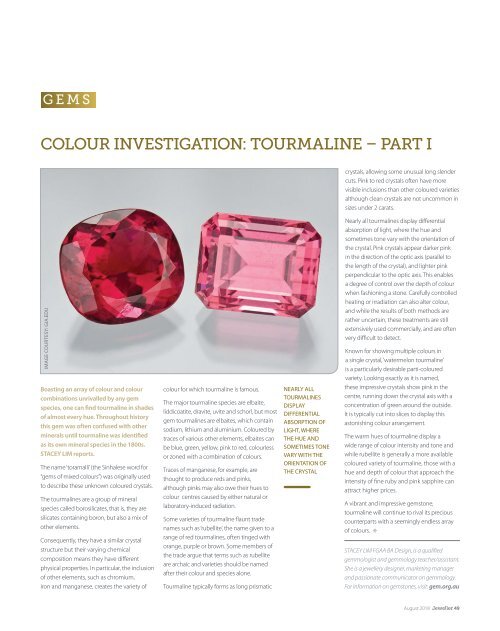You also want an ePaper? Increase the reach of your titles
YUMPU automatically turns print PDFs into web optimized ePapers that Google loves.
GEMS<br />
COLOUR INVESTIGATION: TOURMALINE – PART I<br />
crystals, allowing some unusual long slender<br />
cuts. Pink to red crystals often have more<br />
visible inclusions than other coloured varieties<br />
although clean crystals are not uncommon in<br />
sizes under 2 carats.<br />
IMAGE COURTESY: GIA.EDU<br />
Boasting an array of colour and colour<br />
combinations unrivalled by any gem<br />
species, one can find tourmaline in shades<br />
of almost every hue. Throughout history<br />
this gem was often confused with other<br />
minerals until tourmaline was identified<br />
as its own mineral species in the 1800s.<br />
STACEY LIM reports.<br />
The name ‘toramalli’ (the Sinhalese word for<br />
“gems of mixed colours”) was originally used<br />
to describe these unknown coloured crystals.<br />
The tourmalines are a group of mineral<br />
species called borosilicates, that is, they are<br />
silicates containing boron, but also a mix of<br />
other elements.<br />
Consequently, they have a similar crystal<br />
structure but their varying chemical<br />
composition means they have different<br />
physical properties. In particular, the inclusion<br />
of other elements, such as chromium,<br />
iron and manganese, creates the variety of<br />
colour for which tourmaline is famous.<br />
The major tourmaline species are elbaite,<br />
liddicoatite, dravite, uvite and schorl, but most<br />
gem tourmalines are elbaites, which contain<br />
sodium, lithium and aluminium. Coloured by<br />
traces of various other elements, elbaites can<br />
be blue, green, yellow, pink to red, colourless<br />
or zoned with a combination of colours.<br />
Traces of manganese, for example, are<br />
thought to produce reds and pinks,<br />
although pinks may also owe their hues to<br />
colour centres caused by either natural or<br />
laboratory-induced radiation.<br />
Some varieties of tourmaline flaunt trade<br />
names such as ‘rubellite’, the name given to a<br />
range of red tourmalines, often tinged with<br />
orange, purple or brown. Some members of<br />
the trade argue that terms such as rubellite<br />
are archaic and varieties should be named<br />
after their colour and species alone.<br />
Tourmaline typically forms as long prismatic<br />
NEARLY ALL<br />
TOURMALINES<br />
DISPLAY<br />
DIFFERENTIAL<br />
ABSORPTION OF<br />
LIGHT, WHERE<br />
THE HUE AND<br />
SOMETIMES TONE<br />
VARY WITH THE<br />
ORIENTATION OF<br />
THE CRYSTAL<br />
Nearly all tourmalines display differential<br />
absorption of light, where the hue and<br />
sometimes tone vary with the orientation of<br />
the crystal. Pink crystals appear darker pink<br />
in the direction of the optic axis (parallel to<br />
the length of the crystal), and lighter pink<br />
perpendicular to the optic axis. This enables<br />
a degree of control over the depth of colour<br />
when fashioning a stone. Carefully controlled<br />
heating or irradiation can also alter colour,<br />
and while the results of both methods are<br />
rather uncertain, these treatments are still<br />
extensively used commercially, and are often<br />
very difficult to detect.<br />
Known for showing multiple colours in<br />
a single crystal, ‘watermelon tourmaline’<br />
is a particularly desirable parti-coloured<br />
variety. Looking exactly as it is named,<br />
these impressive crystals show pink in the<br />
centre, running down the crystal axis with a<br />
concentration of green around the outside.<br />
It is typically cut into slices to display this<br />
astonishing colour arrangement.<br />
The warm hues of tourmaline display a<br />
wide range of colour intensity and tone and<br />
while rubellite is generally a more available<br />
coloured variety of tourmaline, those with a<br />
hue and depth of colour that approach the<br />
intensity of fine ruby and pink sapphire can<br />
attract higher prices.<br />
A vibrant and impressive gemstone,<br />
tourmaline will continue to rival its precious<br />
counterparts with a seemingly endless array<br />
of colours. i<br />
STACEY LIM FGAA BA Design, is a qualified<br />
gemmologist and gemmology teacher/assistant.<br />
She is a jewellery designer, marketing manager<br />
and passionate communicator on gemmology.<br />
For information on gemstones, visit: gem.org.au<br />
<strong>August</strong> <strong>2018</strong> <strong>Jeweller</strong> 49


















